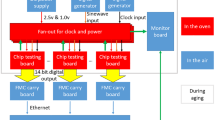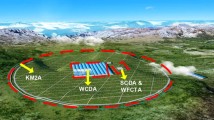Abstract
Objective
The Jiangmen Underground Neutrino Observatory, which is currently being constructed in South China, will be a cutting-edge liquid scintillator detector for neutrino physics in the coming decade. The read-out electronics will be installed in close proximity to the large photomultipliers and directly inside the water pool surrounding the detector. Once installed, these electronics will not be accessible for repair or replacement; therefore, ensuring their reliability is of utmost importance. A crucial aspect of this reliability analysis involves evaluating the failure rate of custom-designed analog-to-digital converter and front-end chips used in underwater read-out electronics.
Methods
The Arrhenius model shall be utilized to compute the reliability failure rate value. During ageing, the ambient temperature of the setup system was set at 115 °C. The high-gain and low-gain output channels were chosen as references for detecting failures in the tested sample for front-end chips of Jiangmen Underground Neutrino Observatory, while for analog-to-digital converters, effective number of bits are considered as reference parameters.
Results
After ageing, all chips were re-measured. The ADC and FEC tests revealed no failures. As a result, the upper limit for the failure rate of front-end chips is 0.43 failures in time, and the upper limit for analog-to-digital converters is 0.42 failures in time at 30 °C.
Conclusion
The reliability test result shows that custom-designed chips can be used in underwater read-out electronics of Jiangmen Underground Neutrino Observatory.










Similar content being viewed by others
References
The JUNO Collaboration, A. Abusleme, The JUNO Collaboration et al., Progr. Part. Nucl. Phys. 123, 103927 (2022)
The JUNO Collaboration, A. Abusleme et al., Chi. Phys. C 46, 123001 (2022)
X. Yang et al., JINST 16, 12040 (2021)
The JUNO Collaboration, A. Abusleme et al., JHEP 11, 102 (2021)
JUNO Conceptual Design Report, https://arxiv.org/pdf/1508.07166.pdf
M. Bellato, A. Bergnoli, A. Brugnera et al., Nucl. Instrum. Methods Phys Res. Sect. A Accel. Spectrom. Detect. Assoc. Equip. 985, 164600 (2021). https://doi.org/10.1016/j.nima.2020.164600
P.D.T. O’Connor, Practical Reliability Engineering, 4th edn. (Wiley, New York, 2010)
R. Jin, J. Hu, J. Ren et al., Radiat Detect Technol Methods 4, 203–207 (2020)
W.B. Nelson, Accelerated Testing-Statistical Models, Test Plans & Data Analysis (Wiley, New York, 2004)
P. Ellerman, MicroNote 1002, 1–6 (2012)
IEEE Std 1057-2007 (Revision of IEEE 1057-1994): IEEE Trial-Use Standard for Digitizing Waveform Recorders. IEEE, 2008IEEE Std 1057-2007 (Revision of IEEE 1057-1994): IEEE Trial-Use Standard for Digitizing Waveform Recorders. IEEE (2008)
Acknowledgements
This project was supported by National Natural Science Foundation of China (No. 12375192) and Youth Innovation Promotion Association CAS (Y829142).
Author information
Authors and Affiliations
Corresponding authors
Ethics declarations
Conflict of interest
On behalf of all authors, the corresponding author states that there is no conflict of interest.
Rights and permissions
Springer Nature or its licensor (e.g. a society or other partner) holds exclusive rights to this article under a publishing agreement with the author(s) or other rightsholder(s); author self-archiving of the accepted manuscript version of this article is solely governed by the terms of such publishing agreement and applicable law.
About this article
Cite this article
Ye, Pr., Yan, Xb., Ning, Z. et al. Reliability studies of the custom-designed front-end and ADC chips used for JUNO large photomultipliers electronics. Radiat Detect Technol Methods (2024). https://doi.org/10.1007/s41605-023-00440-x
Received:
Revised:
Accepted:
Published:
DOI: https://doi.org/10.1007/s41605-023-00440-x




